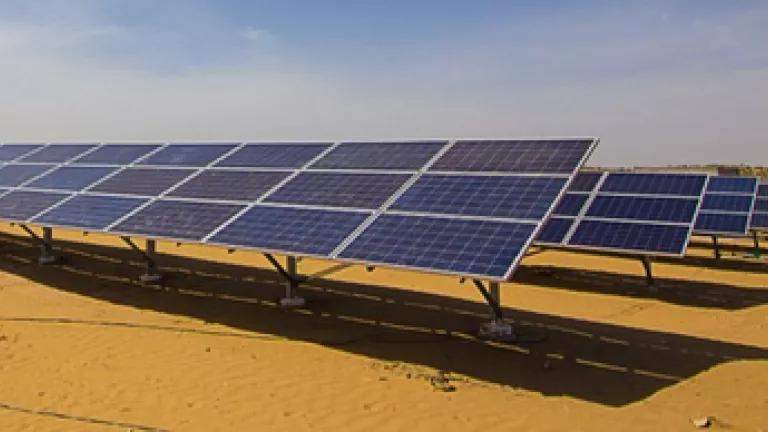
Under Prime Minister Modi's leadership, ÂIndia has redoubled its efforts to ensure smart growth and combat climate change by significantly increasing renewable energy generation capacity. India plans to increase capacity to 175 GW in the next 7 years. To fuel this expansion, clean energy finance has to scale up proportionately. Recent developments portend good progress on this front.
India's renewable energy markets - particularly solar and wind technologies - have received a boost of momentum lately. In a transformative development for the energy sector in India, as per a recent study, solar energy is undercutting coal: new solar PV plants can generate electricity at a cost cheaper than new coal plants running on imported coal. Not surprisingly, in related news, Standard Chartered Bank has withdrawn support for a mega coal mine in Australia which was to be developed by the Adani Group, but now has an uncertain future. Instead, the Adani Group is now in talks with international investors to secure financing for a $3 billion project to make solar cells and panels in the India.
The national government announced a Draft Renewable Energy Act to develop a supportive policy ecosystem for clean energy to flourish. The Ministry of New & Renewable Energy (MNRE) also laid out a timeline of annual targets to lend clarity on how the whopping 100 GW of solar energy could be achieved by 2022 as the market scales up from its current 4 GW of solar.
However, the finance needed to realize these ambitious targets is a significant challenge. Recent examples of sustainable finance - including bond issuances by government, private sector banks and equity and debt listing by companies - indicate significant progress being made in overcoming these barriers. Initiatives currently underway in global and domestic markets show the way forward for financing India's ambitious actions to address climate change.
Achieving the Indian government's goal of installing 100 GW of solar power by 2022 would require nearly $100 billion in finance over seven years. Additional funding will be needed for associated evacuation infrastructure and related grid ancillary services. However, scarcity of low cost, long term financing presents a challenge that must be addressed if India is to meet its capacity addition targets. Solving this challenge requires regulatory changes and financial innovations that allow more investment from domestic institutions and international investors to flow into clean energy.
Emerging Finance Solutions
A range of financial measures are needed to meet India's targets. Green bonds are one such measure and can help unlock institutional and retail investment and mobilize finance for clean energy. Green bonds are similar to any other bond, and help raise capital through debt markets, with a commitment to fund assets delivering an environmental benefit such as renewable energy, low carbon transport or forestry projects.
Initiatives by several Indian domestic institutions indicate a growing interest in such bonds in India. The recent INR 315 crore ($50 million) green bond issue by Yes Bank, one of India's largest commercial banks, will be used to meet its commitment of 5,000 MW renewable energy projects. IFC - part of the World Bank Group - issued a "green Masala bond" on the London Stock Exchange earlier this month for the same amount to invest in the Yes Bank bond, essentially capitalizing it and lowering the cost of lending to green projects. This bond issue follows an issue of INR 1,000 crore ($161 million) green infrastructure bonds by Yes Bank in February. The recent 2,000 crore ($313 million) tax-free bond announced by IREDA (the Indian Renewable Energy Development Agency) - a Government of India financial company - will be used to lend to solar energy projects.
National and subnational governments as well as companies and multinational institutions can issue green bonds. Since the first issue in 2007, market for green bonds has grown rapidly and is expected to reach 100 billion dollars in 2015. Yet, this is a fraction of the debt capital markets of nearly 100 trillion dollars, showing the scale and scope of growth opportunity for global money markets to support sustainable growth over the long-term.
Green IPOs - or initial public offerings are simply the market listing of clean energy companies. Leading renewable energy developer SunEdison recently raised $675 million through an initial public offering (IPO) on Nasdaq. SunEdison listed its Indian renewable energy portfolio on the stock market through subsidiary TerraForm Global - a YieldCo which would provide dividends from sale of electricity by operating the company's renewable energy assets. TerraForm Global also raised $800 million in green bonds to finance global renewable energy projects.
Lastly, initiatives such as the dollar linked power contracts proposed by National Thermal Power Company help attract international investment, reducing hedging costs for solar projects, while protecting power purchasing utilities from currency fluctuations. Green bonds and IPOs and other innovative mechanisms such as the dollar denominated contracts can go a long way in raising capital needed to meet India's ambitious solar targets. The growth of Indian solar industry over the last five years has largely been driven by policy incentives and government push for capacity addition. With the rapidly falling prices of renewable energy, it is time for global money markets to step in a play a greater role in helping India achieve its clean energy targets.

